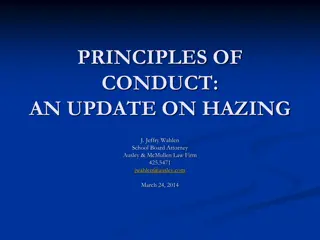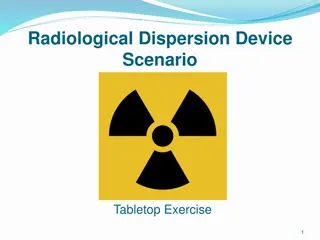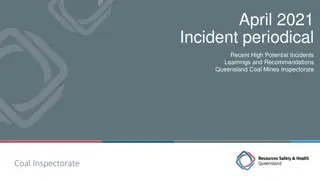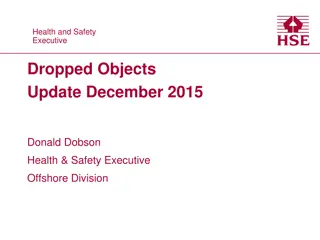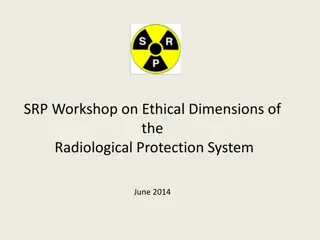Understanding Critical and Non-Critical Incidents in Incident Reporting
Critical incidents, as defined by regulations, are serious events that pose immediate risk to health, safety, or welfare. Non-critical incidents, on the other hand, are minor in nature and do not have serious consequences. Incident reports play a crucial role in documenting occurrences, identifying
0 views • 29 slides
Comprehensive Guide to Initial Operational Response (IOR) in Hazardous Substance Incidents
This guide outlines the objectives, principles, and key elements of Initial Operational Response (IOR) to incidents involving hazardous substances or CBRN materials. It covers the stages of response, transition to Specialist Operational Response (SOR), primary objectives of IOR, JESIP principles, an
4 views • 25 slides
Radiological Emergency Preparedness Program Assessment Guidance
This module covers the assessment policies and guidance for radiological emergency preparedness programs. It includes key concepts such as metrics for program evaluation, FEMA's assurance determination process, specific demonstration requirements, capability targets, and critical tasks. Participants
4 views • 22 slides
Reporting Incidents on Sphera
The Council utilizes Sphera to manage health and safety risks, requiring employees to report accidents, near misses, violence incidents, and more promptly. This guide explains how to report incidents on Sphera, including accessing the reporting portal, completing mandatory fields, and obtaining pape
9 views • 26 slides
Understanding Critical Incidents for Personal Growth
Critical incidents are integral learning opportunities that can lead to significant personal development. They do not necessarily involve danger but are situations that prompt deeper reflections. The BCU Assessment tracker is used to track progression towards key themes. The associated teacher's pro
1 views • 4 slides
IAEA series of lectures on Quality Management in Medical Radiological Practices
Quality management in medical radiological practices is crucial for ensuring the delivery of high-quality healthcare services. This series of lectures covers topics such as the basics of quality, roles and responsibilities, key performance indicators, drafting policies, developing a quality manual,
4 views • 54 slides
Comprehensive Insights into Quality Management in Medical Radiological Practices
Explore a series of lectures by the IAEA focusing on quality management in medical radiological practices, covering essential topics such as the basics of quality, key performance indicators, drafting policies, equipment management, and more. Gain a thorough understanding of KPIs, their significance
0 views • 48 slides
Future of Radiological and Nuclear Defense Programs and Capabilities
The Radiological and Nuclear Defense Capability Development Directorate discusses the responsibility for modernizing and procuring defense capabilities in the face of radiological and nuclear threats. The Department of Defense outlines strategic priorities to ensure the ability to survive and prevai
1 views • 10 slides
Process Safety Incidents and Prevention Best Practices
Process safety incidents involving hazardous materials like caustic solutions, ammonia leaks, and TFE have caused injuries and fatalities. Key incidents include burns from caustic exposure, fatalities due to ammonia leaks, and an explosion from improper TFE handling. Learning from these incidents hi
7 views • 21 slides
Radiological Features and Clinical Presentations of Intestinal Obstruction
Intestinal obstruction can manifest with various clinical features such as sudden severe pain, tenderness, fever, and more. Imaging plays a crucial role in diagnosing obstruction, with X-rays showing characteristic findings in the small bowel and colon. Different types of obstructions like strangula
0 views • 43 slides
Clinical Incidents and Complaints: Understanding, Management, and Prevention
Explore the definition of clinical incidents, learn how to recognize and react to them, understand patient complaints, and discover ways to prevent incidents and complaints in healthcare settings. Discover who to report incidents to and how healthcare organizations handle complaints. Gain insights i
0 views • 12 slides
Analysis of Assault Incidents in Relation to Police Officers
This data presents a detailed analysis of assault incidents involving police officers, categorized by assault level, alcohol-related factors, and year. The data covers non-criminal and criminal incidents, as well as the combined total incidents over the years 2019, 2020, and 2021.
0 views • 36 slides
Camp and Club Incidents at 4-H Programs
Various incidents occurred at 4-H programs involving negligence, resulting in injuries to participants. From a camper injured by a protruding nail, to an accident caused by a faulty van, and accidents during horse riding and archery activities, these incidents highlight the importance of ensuring sa
0 views • 11 slides
Update on Hazing Incidents in Schools: Consequences and Lessons
Recent hazing incidents in schools have raised concerns, with various cases involving freshmen being subjected to harmful practices by senior students. These incidents have led to legal repercussions, jail time, probation, and community backlash. The stories highlight the importance of vigilance by
0 views • 39 slides
Regulatory Changes and Quality Improvement in October 2018
The content discusses regulatory changes related to risk and quality improvement in October 2018, focusing on serious incidents, reporting requirements, risk management, and monitoring service quality. Providers are mandated to review, analyze trends, identify systemic issues, recommend remediation,
0 views • 31 slides
Radiological Dispersion Device Tabletop Exercise Overview
This tabletop exercise focuses on simulating a radiological dispersion device scenario to enhance emergency response readiness and assess response plans. The exercise includes agenda discussions, administrative details review, scenario analysis, facilitated discussions, action planning sessions, and
0 views • 32 slides
Recent High-Potential Incidents and Recommendations in Queensland Coal Mines
The Queensland Coal Mines Inspectorate has reported several serious accidents and high-potential incidents, including injuries, equipment failures, and near-miss collisions. Recommendations include auditing safety controls, enhancing training for mobile plant operators, and ensuring compliance with
0 views • 15 slides
Radiological Protection in Paediatric Diagnostic and Interventional Radiology
Radiological protection in paediatric diagnostic and interventional radiology is crucial due to the higher risk per unit of radiation dose for infants and children compared to adults. The justification for using radiological examinations should prioritize patient benefits, with emphasis on optimizat
0 views • 36 slides
Recent High Potential Incidents and Recommendations - Queensland Coal Mines Inspectorate
The July 2022 incident periodical by the Queensland Coal Mines Inspectorate highlights two significant incidents involving a tyre fire and a CMW crush injury. Recommendations include improving road conditions, enhancing emergency response procedures, and ensuring proper task planning and risk assess
0 views • 14 slides
Responding to Incidents Related to Culture and Identity in Issaquah School District: Parent Workshop Summary
In this session by the Equity and Family Partnership Department along with school counselors in Issaquah School District, parents were guided on how to support their children in reporting and responding to incidents related to culture and identity at middle and high school levels. The importance of
0 views • 26 slides
Reporting Accidents and Incidents at Work: Understanding RIDDOR Regulations 2013
The Reporting of Injuries, Diseases, and Dangerous Occurrences Regulations 2013 (RIDDOR) outlines the legal requirements for reporting work-related accidents and incidents. It specifies what must be reported, who to report to, types of reportable accidents, recording requirements, and how to report
0 views • 9 slides
Understanding Disability Hate Crime and Hate Incidents
Disability hate crime and incidents involve criminal offenses or non-crime incidents perceived as motivated by hostility or prejudice towards a person's disability. Key elements include hostility, prejudice, perception, and may involve racial, religious, or sexual orientation hate. Perceptions are c
0 views • 16 slides
Addressing Bias-Related Incidents at Concordia University
The report discusses bias reporting at Concordia University, highlighting the importance of understanding and addressing bias-related incidents. It covers examples of bias, distinction between bias incidents and hate crimes, and strategies for response. Presenters from the Office of Multicultural En
0 views • 11 slides
Understanding the Hazards of Arc Flash Incidents by Littelfuse Startco
Littelfuse Startco highlights the dangers of arc flash incidents, emphasizing the costly and dangerous consequences such as fires, burns, injuries, and even fatalities. The case study of an electrician's severe burns serves as a stark reminder of the potential risks associated with electrical hazard
0 views • 24 slides
Nuclear Security Culture and Managerial Role: Insights from IAEA Conference
Exploring the concept of security culture in nuclear facilities, this presentation by Carsten Speicher at the IAEA International Conference on Nuclear Security delves into the role of managers in fostering a positive security culture. It discusses the risks posed by radiological terrorists and the p
0 views • 16 slides
Understanding Reportable Incidents in Developmental Disability Care
The report outlines the criteria for incidents to be classified as reportable in the context of intellectual and developmental disabilities care. It covers various types of incidents, including abuse, neglect, serious injuries, and behavioral or medical incidents requiring specific interventions. Th
0 views • 28 slides
Understanding Radiation Safety in Cone Beam CT Imaging
Cone Beam CT (CBCT) technology has revolutionized imaging in various medical fields, presenting unique radiological protection challenges. This summary highlights the importance of optimizing radiological protection for patients and workers using CBCT, emphasizing the need for informed decision-maki
0 views • 24 slides
Offshore Health and Safety Executive Report on Dropped Objects Incidents in 2015
The Health and Safety Executive report provides a detailed overview of dropped objects incidents in the offshore industry during 2015. The report includes data on quarterly totals, types of incidents, and specific cases of objects being dislodged and falling. Various scenarios involving derricks, cr
0 views • 13 slides
Clinical Incidents, Complaints, and Learning Objectives in Healthcare
Understand the importance of recognizing and reacting to clinical incidents, handling patient complaints, and learning from adverse events. Learn about the definition of clinical incidents, who to inform, and the process of reporting incidents in healthcare settings. Discover reasons behind patient
0 views • 12 slides
Effective Equipment Management in Medical Radiological Practices
This presentation focuses on key aspects of managing medical equipment within a Quality Management System in radiological practices. It covers topics such as the importance of quality, roles and responsibilities, equipment procurement procedures, and developing a successful Equipment Management Syst
0 views • 32 slides
Food Defense Training and Rapid Response Team Meeting Overview
Food Defense Training and Rapid Response Team Meeting provides insights into food security, food defense, and food safety to protect against intentional and unintentional contamination incidents. The presentation delves into incidents, policies, responses, and preparedness, emphasizing the importanc
0 views • 24 slides
Comprehensive Radiological Imaging Review in Abdominal and Adrenal Pathologies
This extensive radiological imaging review covers a wide range of topics in abdominal and adrenal pathologies, discussing differential diagnoses, imaging modalities such as CT and USG, specific syndromes like prune belly syndrome, and conditions like retroperitoneal fibrosis. It delves into various
0 views • 39 slides
Vulnerability of Radiological Materials to Theft by Terrorist Groups in US Civilian Entities
The vulnerability of radiological materials stored at US civilian entities to theft by terrorist groups, particularly low-activity sources, remains a significant concern. Security measures primarily focus on high-activity sources, leaving lower activity sources neglected and highly susceptible to ex
0 views • 16 slides
Workshop on Ethical Dimensions of Radiological Protection System
This workshop focuses on exploring the ethical values within the radiological protection system, addressing practical implementation aspects that raise ethical questions. It aims to improve understanding, communication, and management of radiation risk, building on previous workshops' outcomes. The
0 views • 10 slides
Workplace Incident Investigation and Root Cause Analysis
Workplace incident investigations are crucial for preventing future incidents. They help determine what happened, identify causes, and uncover unsafe conditions or procedures. By conducting thorough investigations, management can take corrective actions and demonstrate commitment to safety. Understa
0 views • 17 slides
Indoor Chemical and Radiological Risk Monitoring Study
The (IN.SITU) Chemical and Radiological Risk in the Indoor Environment (CHeRRIE) study conducted measurements of radon concentrations and e-perm levels in indoor environments from Oct. 2014 to March 2015. The findings show variations in radon and e-perm levels at different times of the day and acros
0 views • 14 slides
Understanding Barium Meal Radiological Study
Barium meal is a radiological study of the upper gastrointestinal tract, including the esophagus, stomach, duodenum, and proximal jejunum. It helps diagnose various conditions such as peptic ulcers, cancers, and gastrointestinal obstructions. The procedure involves oral administration of barium cont
0 views • 11 slides
Radiological Job Coverage and Operating Experience Review
Explore the importance of proper job coverage in radiological tasks, focusing on a specific incident involving workers entering the wrong location inside a high radiation area. Learn valuable lessons on following procedures, training, and maintaining continuous job coverage to ensure safety. Underst
0 views • 139 slides
Understanding Serious Incidents Reporting and Investigations in Bikeability Program
The Serious Incidents Reporting and Investigations guide provides crucial information on responsibilities, reporting procedures, and types of incidents such as safeguarding, health and safety, data breaches, and risks to reputation. It emphasizes timely reporting, record-keeping, and continuous lear
0 views • 20 slides
Xoserve Incident Summary - July 2020
This presentation provides an overview of P1/2 incidents experienced by Xoserve in July 2020. It describes high-level impacts, causes, and resolutions undertaken by Xoserve to address the incidents. The information is shared to give customers insight into Xoserve's platforms supporting critical busi
0 views • 7 slides













